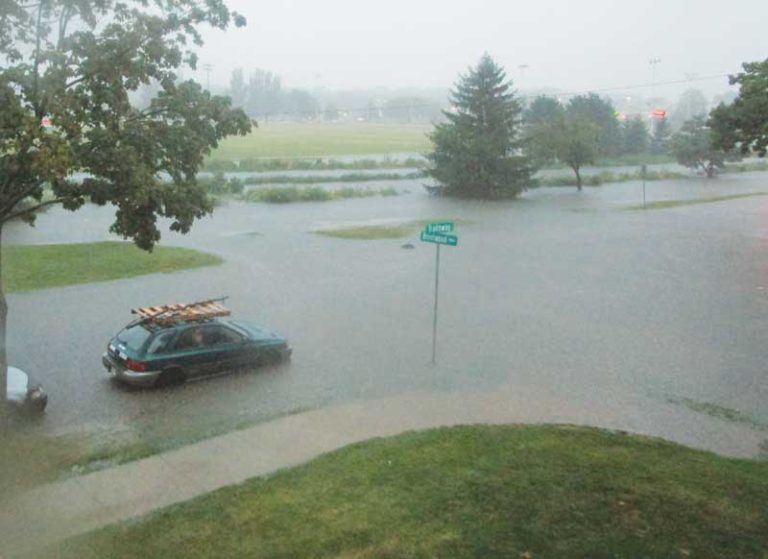
By Kathlean Wolf
Northside News
The evening of July 21, up to 3 inches of rain fell on the Northside. It was not the first or the last major rain of the 2016 summer season, but the intensity of the storm caused some of the worst flooding our area has seen since 2008. Castle Creek, the stormwater runoff route for over 500 acres of Northside neighborhoods, rose an astonishing 7 feet in less than an hour, pouring out onto adjacent streets, creeping up lawns and flooding basements. Cars parked along Trailsway Street, Brentwood Parkway and Calypso Road suffered damage to foot well carpets and engines as the dirty water rose above their hubcaps.
The flood found the streets of Brentwood Village lined with bins of recycling and trash awaiting pick up the next morning. As waters rose a foot or more, many of them floated upward then tipped over, spilling their contents into the floodwaters. Bags full of kitchen scraps, plastic bottles, diapers and a thousand other discarded items began making their soggy way toward Castle Creek.
Wearing water shoes and swim trunks, I waded into the water to intercept first one bag, then two more, and hauled them to the nearest spit of solid land. As I chased down more floating trash bags, I was joined by two neighbors, pulling the tipped-over trash bins upright, then wrestling them onto nearby lawns. An hour later, as the rain tapered off and the water slowly receded, we’d halted the flow of trash headed toward Warner Pond.
Warner Pond receives the runoff from 1,200 acres through five major stormdrain outflows. With only one outflow beneath the railroad berm, the volume of water draining into Warner Pond is much greater than the volume draining into Lake Mendota. Where water speed slows, trash is no longer carried along, making Warner Pond into a final resting place for much of the street debris of the Northside.
While many cities design stormwater systems that prevent trash, oil, road salt and other debris from flowing into the lakes and streams, Madison’s street drains enter our communal waters untreated. Even when settlement basins are built into the system, dissolved pollutants, such as road salt, fertilizers and pesticides, flow into ponds and lakes unimpeded.
This flood had destructive power, but what if it could be a catalyst for improving the way we look at our water, and our trash, as Northsiders? By intercepting the flood-driven trash bombs before they headed downstream, just three neighbors prevented revolting items such as diapers and rotten food from escaping into the waters we fish from, swim in and ultimately drink from. Is there a way to prevent such severe flooding in the first place — even in the face of such an extreme deluge? Can we find ways to prevent street litter, yard waste and chemicals from impacting our entire lake system?
While these appear to be issues best left to city engineers, in fact, our collective decisions can have a much greater impact on our water quality and flood response than any of the available engineering solutions. In upcoming editions, look for discussions on ways that each of us on the Northside can make a big difference for our water quality, our urban ecosystem and the quality of life on the Northside.